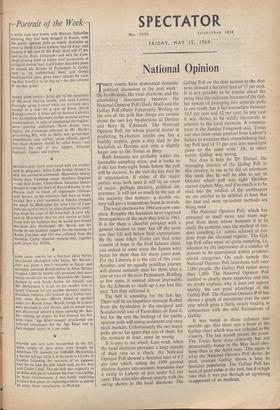National Opinion T rTHREE events have dominated domestic 1 political discussion
in the past week : the by-elections, the local elections, and the astonishing discrepancy between the National Opinion Poll (Daily Mail) and the Gallup Poll (Daily Telegraph). Writing on the eve of the poll few things are certain about the two key by-elections at Devizes and Bury St. Edmunds. The National Opinion Poll, for whose general record in predicting by-election results one has a healthy respect, gives a tiny lead to the Socialists at Devizes and only a slightly larger one to the Tories at Bury.
Both forecasts are probably within the inevitable sampling error, and it looks as if the last forty-eight hours before the poll will be decisive. In the end the key may be in organisation. If either of the major parties wins both seats it will be an event of major, perhaps decisive, political im- portance. It will not so much be the size of the majority that matters : a double vic- tory will give a tremendous boost to morale.
The local elections for 1964 are now com- plete. Roughly the Socialists have regained three-quarters of the seats they lost in 1961. It is for them a cheerful prospect with a general election so near, but all- the same one that fell well below their expectations. By the same token Tories can find some crumbs of hope in the final balance sheet, and indeed in some areas the figures were better for them than for many years past. For the Liberals it is the end of this road. Another, and an equally pointless journey will almost certainly start for them after a year or two of the next Parliament. Holding so few seats, it seemed almost impossible for the Liberals to chalk up a net loss this year. Yet they achieved it.
The bell is sounding for the last lap. There will be an important message flashed from the by-election in the marginal and Socialist-held seat of Faversham on June 4, but for the rest the findings of the public opinion polls will swing sentiment and sway stock markets. Unfortunately the two major polls are so far apart that one of them, for the moment at least, must be wrong.
It is easy to see which. Last week, when the local elections provided a huge sample of their own as a check, the National Opinion Poll showed a Socialist lead of 8.7 per cent which, taking the 1959 general election figures into account, translates into a swing to Labour of just under 6.5 per cent. This coincides almost exactly with the swing shown in the local elections. The Gallup Poll on the date nearest to the elec- tions showed a Socialist lead of 17 per cent. It is not possible' to be precise about the swing that this indicates because of the Gal- lup system of averaging two separate polls in one result, but it lies somewhere between 10.5 per cent and 12 per cent. In any case it was shown to be wildly inaccurate in relation to the local elections. A commen- tator in the Sunday Telegraph said, 'Tories can also draw some comfort from Labour's failure to translate their overwhelming Gal- lup Poll lead of 17 per cent into municipal gains on the same scale.' Or, in other words, Gallup was wrong.
Nor does it help for Dr. Durant, the managing director of the Gallup Poll in this country, to say as he did on television this week that he will be able to say in October which poll was right. October cannot explain May, and if so much is to be read into the verdicts of the soothsayers we are entitled to be satisfied at least that the best and most up-to-date methods are being used. The National Opinion Poll, which has attracted to itself more and more sup- port from those whose business it is to study the portents, uses the method of ran- dom sampling, i.e. names selected at ran- dom from the electoral register. The Gal- lup Poll relies more on quota sampling, i.e. selection by the interviewer of a number of persons to be interviewed within predeter- mined categories. On each sample the National Opinion Poll interviews well over 2.000 people, the Gallup Poll rather more than 1,000. The National Opinion Poll method is clearly more expensive and this no doubt explains why it does not appear weekly, the one great advantage of the Gallup Poll. The National Opinion Poll has shown a graph of movement over the past year which gives a fairly steady reading in comparison with the wild fluctuations of . Gallup. It was noted in these columns two months ago that there was a fever in the Gallup chart which was not reflected in the country. The last month proves the point. The Tories have done distinctly but not dramatically better in the May local elec- tions than in the April ones. This again is what the National Opinion Poll shows. In stark contrast Gallup shows a leap in Socialist popularity. The Gallup Poll has been_of great value in the past, but it is high time that it was put through an agonising re-appraisal of its methods.






























 Previous page
Previous page